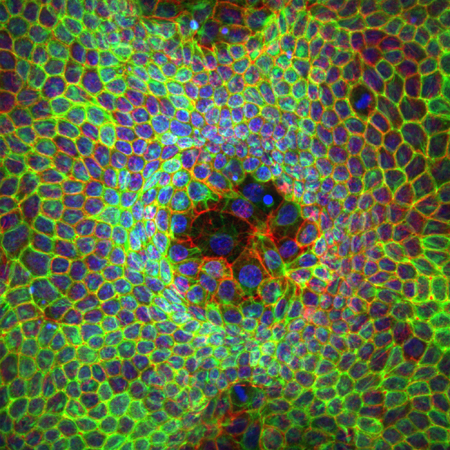Today, researchers at IBEC and the UPC report a new physical property of cells – which they’re calling active superelasticity – that may explain the unusual ability of cells to undergo extreme deformations.
The team, led by Marino Arroyo and Xavier Trepat (centre and right), developed a new approach to subject epithelial tissues – the thin cellular layers that cover internal and external surfaces of the body – to very large deformations, up to four times their original size. These cellular layers are fundamental to life, as they protect the body from radiation, pollutants and pathogens. They’re also responsible for gas exchange in the lungs, absorption of nutrients in the gut, and excretion of urine in the kidneys.

“Most materials are unhappy during stretching. As they become progressively deformed, they’ll want to go back to their unstretched state, like a rubber band, or may even break as the tension increases,” says Marino Arroyo, professor at the Polytechnic University of Catalonia and Associated Researcher at IBEC. The team found that the epithelial sheets have a different and unusual mechanical behavior. To their surprise, tissues did not break during stretching, and they were able to recover their initial size in a fully reversible way when unstretched. Even more surprisingly, some cells in the tissue barely stretched, while others became ‘superstretched’, increasing their area more than ten times.
The authors identified the molecular mechanisms that explain this physical behavior, which they call ‘active superelasticity’ as an analogy with the behavior of some high-tech metal alloys used in medical technologies. As cells become stretched, they become equally happy in an unstretched state or in a super-stretched state. As a result, these cell sheets can deal with increasing stretch by progressively switching cells into their super-stretched state without increasing tension, which would otherwise compromise integrity or cohesion. “We’re all familiar with superheroes like Ms Marvel or The Incredibles, who are able to stretch their bodies beyond human limits. It is fun to think that our cells are also super-stretchable. We’re made of super-hero cells!” says Xavier Trepat, IBEC group leader and ICREA research professor.
“Understanding this surprising mechanical behavior in epithelial tissues could help us build better artificial organs or new bionic technologies such as organs-on-a-chip,” says Ernest Latorre (left) of IBEC’s Integrative Cell and Tissue Dynamics group and first author of the study.
—
This work was supported by the Spanish Ministry of Economy and Competitiveness/FEDER (BFU2015-65074-P to X.T., DPI2015-71789-R to M.A., SAF2017-89782-R to NM, SAF2015-72617-EXP to N.M., RYC-2014-16242 to N.M.), the Generalitat de Catalunya and CERCA program (2014-SGR-927 to X.T., 2017-FI-B1-00068 grant to E.L., 2014-SGR-1471 to M.A., 2017 SGR 1306 to N.M., ‘ICREA Academia’ award to M.A.), the European Research Council (CoG-616480 to X.T., CoG-681434 to M.A., CoG-617233 to B.L., StG-640525 to N.M.), European Commission (project H2020-FETPROACT-01-2016-731957 to M.A., A.d.C. and X.T.), LABAE16006 to N.M., Instituto de Salud Carlos III (CardioCell, TerCel to N.M.), the Deutsche Forschung Gemeinschaft (SFB 1027 to A.d.C.) and Obra Social ‘La Caixa’. IBEC is recipient of a Severo Ochoa Award of Excellence from the MINECO.—
Soure article: Ernest Latorre, Sohan Kale, Laura Casares, Manuel Gomez-Gonzalez, Marina Uroz, Léo Valon, Roshna V. Nair, Elena Garreta, Nuria Montserrat, Aránzazu del Campo, Benoit Ladoux, Marino Arroyo & Xavier Trepat (2018). Active superelasticity in three-dimensional epithelia of controlled shape. Nature, pub ahead of print





